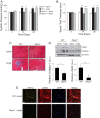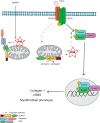Mitochondrial NLRP3 protein induces reactive oxygen species to promote Smad protein signaling and fibrosis independent from the inflammasome
- PMID: 24841199
- PMCID: PMC4094069
- DOI: 10.1074/jbc.M114.550624
Mitochondrial NLRP3 protein induces reactive oxygen species to promote Smad protein signaling and fibrosis independent from the inflammasome
Abstract
Nucleotide-binding domain and leucine-rich repeat containing PYD-3 (NLRP3) is a pattern recognition receptor that is implicated in the pathogenesis of inflammation and chronic diseases. Although much is known regarding the NLRP3 inflammasome that regulates proinflammatory cytokine production in innate immune cells, the role of NLRP3 in non-professional immune cells is unclear. Here we report that NLRP3 is expressed in cardiac fibroblasts and increased during TGFβ stimulation. NLRP3-deficient cardiac fibroblasts displayed impaired differentiation and R-Smad activation in response to TGFβ. Only the central nucleotide binding domain of NLRP3 was required to augment R-Smad signaling because the N-terminal Pyrin or C-terminal leucine-rich repeat domains were dispensable. Interestingly, NLRP3 regulation of myofibroblast differentiation proceeded independently from the inflammasome, IL-1β/IL-18, or caspase 1. Instead, mitochondrially localized NLRP3 potentiated reactive oxygen species to augment R-Smad activation. In vivo, NLRP3-deficient mice were protected against angiotensin II-induced cardiac fibrosis with preserved cardiac architecture and reduced collagen 1. Together, these results support a distinct role for NLRP3 in non-professional immune cells independent from the inflammasome to regulate differential aspects of wound healing and chronic disease.
Keywords: Fibrosis; Heart Failure; Inflammation; Myofibroblast; Transforming Growth Factor β (TGFβ).
© 2014 by The American Society for Biochemistry and Molecular Biology, Inc.
Figures










Similar articles
-
Serelaxin inhibits the profibrotic TGF-β1/IL-1β axis by targeting TLR-4 and the NLRP3 inflammasome in cardiac myofibroblasts.FASEB J. 2019 Dec;33(12):14717-14733. doi: 10.1096/fj.201901079RR. Epub 2019 Nov 5. FASEB J. 2019. PMID: 31689135
-
Relaxin Inhibits the Cardiac Myofibroblast NLRP3 Inflammasome as Part of Its Anti-Fibrotic Actions via the Angiotensin Type 2 and ATP (P2X7) Receptors.Int J Mol Sci. 2022 Jun 25;23(13):7074. doi: 10.3390/ijms23137074. Int J Mol Sci. 2022. PMID: 35806076 Free PMC article.
-
Angiotensin (1-7) inhibits arecoline-induced migration and collagen synthesis in human oral myofibroblasts via inhibiting NLRP3 inflammasome activation.J Cell Physiol. 2019 Apr;234(4):4668-4680. doi: 10.1002/jcp.27267. Epub 2018 Sep 24. J Cell Physiol. 2019. PMID: 30246378
-
Regulation and Function of the Nucleotide Binding Domain Leucine-Rich Repeat-Containing Receptor, Pyrin Domain-Containing-3 Inflammasome in Lung Disease.Am J Respir Cell Mol Biol. 2016 Feb;54(2):151-60. doi: 10.1165/rcmb.2015-0231TR. Am J Respir Cell Mol Biol. 2016. PMID: 26418144 Free PMC article. Review.
-
NLRP3 inflammasome: from a danger signal sensor to a regulatory node of oxidative stress and inflammatory diseases.Redox Biol. 2015;4:296-307. doi: 10.1016/j.redox.2015.01.008. Epub 2015 Jan 14. Redox Biol. 2015. PMID: 25625584 Free PMC article. Review.
Cited by
-
Inflammasome as an Effective Platform for Fibrosis Therapy.J Inflamm Res. 2021 Apr 20;14:1575-1590. doi: 10.2147/JIR.S304180. eCollection 2021. J Inflamm Res. 2021. PMID: 33907438 Free PMC article. Review.
-
Complement-induced activation of the cardiac NLRP3 inflammasome in sepsis.FASEB J. 2016 Dec;30(12):3997-4006. doi: 10.1096/fj.201600728R. Epub 2016 Aug 19. FASEB J. 2016. PMID: 27543123 Free PMC article.
-
Potential Impact of Bioactive Compounds as NLRP3 Inflammasome Inhibitors: An Update.Curr Pharm Biotechnol. 2024;25(13):1719-1746. doi: 10.2174/0113892010276859231125165251. Curr Pharm Biotechnol. 2024. PMID: 38173061 Review.
-
The Role of Inflammasome-Dependent and Inflammasome-Independent NLRP3 in the Kidney.Cells. 2019 Nov 5;8(11):1389. doi: 10.3390/cells8111389. Cells. 2019. PMID: 31694192 Free PMC article. Review.
-
Monocyte and macrophage contributions to cardiac remodeling.J Mol Cell Cardiol. 2016 Apr;93:149-55. doi: 10.1016/j.yjmcc.2015.11.015. Epub 2015 Nov 21. J Mol Cell Cardiol. 2016. PMID: 26593722 Free PMC article. Review.
References
-
- van den Borne S. W., Diez J., Blankesteijn W. M., Verjans J., Hofstra L. (2010) Myocardial remodeling after infarction: the role of myofibroblasts. Nat. Rev. Cardiol. 7, 30–37 - PubMed
-
- Petrov V. V, Fagard R. H., Lijnen P. J. (2002) Stimulation of collagen production by transforming growth factor-B1 during differentiation of cardiac fibroblasts to myofibroblasts. Hypertension 39, 258–263 - PubMed
-
- Di Guglielmo G. M., Le Roy C., Goodfellow A. F., Wrana J. L. (2003) Distinct endocytic pathways regulate TGF-β receptor signalling and turnover. Nat. Cell Biol. 5, 410–421 - PubMed
-
- Xu L., Chen Y. G., Massagué J. (2000) The nuclear import function of Smad2 is masked by SARA and unmasked by TGFβ-dependent phosphorylation. Nat. Cell Biol. 2, 559–562 - PubMed
-
- Wrana J. L., Attisano L., Wieser R., Ventura F., Massagué J. (1994) Mechanism of activation of the TGFβ receptor. Nature 370, 341–347 - PubMed
Publication types
MeSH terms
Substances
Grants and funding
LinkOut - more resources
Full Text Sources
Other Literature Sources
Molecular Biology Databases

